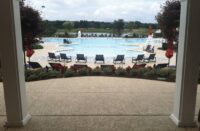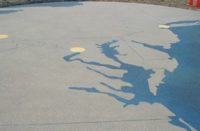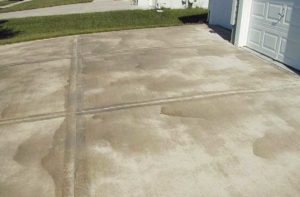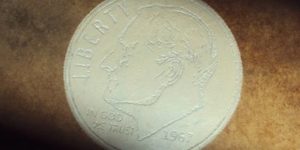Question: I have an exterior raised wooden deck that has a cement-based overlay applied to the top. The area that is under roof is fine, but the area that is outside is failing. The edges are crumbling, the steps are falling apart and there is a section we had to cover with plywood because a hole developed. We have had a few contractors quote the job and the prices are very high. Most want to replace the entire deck. Why is the outside part failing? Do we need to replace it all, or can we just replace the portion not under roof? One installer quoted a 10-part process with many layers of waterproofing. Our insurance company is asking for proof that this many steps are necessary. Any help or advice would be appreciated.

I have often said that the decorative concrete industry uses what other trades have known for decades and improves it. In this case we can look to the tile industry and learn from what they have known for years. Cement-based materials do not do well when applied directly to wooden substrates, especially when exposed to the elements.
Transition layers such as mortar beds and cement board are mandatory when transitioning from plywood flooring or decking to cement-based systems such as overlays. These cement-based transition layers provide durability, rigidity and the proper surface for tile or concrete overlays. In this case there was no transition layer installed. This is why the cement-based topping has cracked in many places, which was not even mentioned in the email but can be seen in the pictures.
That aside, the main reason for the massive failure of the exposed portion of the deck is the lack of any waterproofing layers between the overlay and the wooden deck. Water migrated through cracks, seams and edges into the wooden subfloor and joists and, over a few years, rotted the wood.
When I visited the site I also discovered that the deck was built with interior-grade OSB (oriented strand board) joists, along with interior-grade plywood. Because interior-grade lumber was used, the bottom of the deck was closed in and finished. While the intent to protect the joist and plywood deck from the elements was good, this decision actually worked against them. Because the joists and plywood decking were closed in, there was no air movement. Once moisture migrated into the wood, the lack of air allowed it to collect and rot the wood. The low-humidity environment of northern Colorado would actually have dried the wood out if it had been exposed, improving the longevity of the deck in the long run.

Overall, not only does the installation not meet local building codes, but it is outright dangerous and was doomed to fail considering the interior-grade materials that were used, lack of waterproofing and substandard installation. It should be noted that the concrete overlay is in excellent condition under the covered portion of the deck, and even on the outside portion of the deck the overlay itself is performing. It’s the rotting and disintegrating subbase that is causing the failure. This says a lot for the durability and performance of decorative concrete overlays even in the most adverse conditions.
In regard to the question of whether the exposed portion can be replaced or the entire deck needs to be fixed, I would recommend that the entire deck be replaced.
While it is not impossible to replace just the failing outside section, matching the color and texture will be difficult. In my experience, no matter how accurate the color match, the new section will look different and the repair will be very noticeable — although I should note that I have seen repairs similar to this where the new section was installed in a different color or texture, eliminating the guesswork of color-matching.

The bigger factor in recommending that the entire deck be replaced is that even the section under roof, which currently looks OK, will deteriorate sooner rather than later because of the substandard materials and installation. Because the underneath portion of the deck is finished and closed in, there is no way of knowing the true condition of the wooden joists and subfloor. I feel it is better to replace it all at once rather than having to go through a second massive replacement a few years down the road.
The insurance company need not look much further then the current condition of the deck, paying close attention to the 4-foot-wide hole in the middle that is currently covered with plywood, as proof that waterproofing is necessary. If that is not enough, the soaking wet and rotting wooden joists and plywood are another smoking gun reinforcing why waterproofing is critical in this type of installation.
After researching many decorative manufacturers that offer deck coatings, I see that the reputable ones all recommend seven- to 12-step processes for this type of application. The steps include but are not limited to:
1. Priming the wooden subfloor
2. Metal lath and repair mortar or cement board
3. Primer
4. Waterproof coating (either liquid-applied or a rigid membrane)
5. Optional second coat of waterproof coating
6. Primer
7. Scratch coat of decorative overlay
8. Body coat of decorative overlay
9. Optional finish coat of decorative overlay
10. Sealer system
While the systems by manufacturer will vary, I would be skeptical of any system that does not include at least one layer of the four major sections (subfloor transition, waterproofing, decorative overlay, sealer system) with the proper primers between each layer. This may seem like overkill to some, but without the proper layers and transitions, water and rot will destroy or cause delamination of these types of exterior deck systems.
It is not a surprise why substandard decks like this are installed. The expense of doing it right can be higher than most other decking materials. In many cases the materials alone for the system as outlined above can run $4 to $6 per square foot. That being said, an exterior decorative concrete deck system installed properly will outlast wood by decades without much maintenance, providing aesthetic value and looks that you just cannot get with any other building material.















